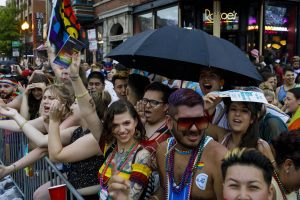The Centers for Disease Control and Prevention recommends that fully vaccinated Americans can, in most cases, avoid wearing masks outdoors. But this group of nearly 100 million, scattered across the country, remains for now under the authority of a patchwork of mask mandates, varying by state and sometimes by county, dictating when and where face coverings should be worn.
Some states, like Arizona and Texas, have already lifted mask mandates. But most indoor mask mandates could be eased or eliminated by the summer, said Dr. Arthur Reingold, chair of the epidemiology division at the School of Public Health at the University of California, Berkeley — as long as people continue to get vaccinated, and as long as the United States avoids the troubling waves it has endured over the past year.
About 2.7 million Covid-19 vaccine doses are being administered nationally each day on average — a drop from the peak of more than 3.3 million this month, when those who were most eager and able to get shots were getting them quickly.
By summer, Dr. Reingold said, “there won’t be big regional differences” in mask wearing as there are now. Strict outdoor masking has been standard behavior in urban centers like New York City and San Francisco, but less common in other parts of the country.
The C.D.C. on Tuesday advised that Americans who are fully vaccinated against the coronavirus no longer need to wear masks outdoors, except in some cases, like during large gatherings.
Gov. Andrew M. Cuomo said that New York would adopt the C.D.C.’s guidance on outdoor mask wearing, and Gov. Gavin Newsom of California said, “If you’re fully vaccinated, outdoors and not in a large crowd — you do not need to wear a mask.”
A federal mask policy “was always going to be somewhere between difficult and impossible to achieve” in the United States, Dr. Reingold said. Still, outside of places like airports and stores — where strictly enforced mask requirements have sometimes led to heated confrontations — mask wearing has often been an individual choice, as local government mask mandates have rarely led to fines or punishment.
The C.D.C. is maintaining its advice on other safety measures, saying that all adults should wear masks and stay six feet apart at outdoor performance and sporting events and in indoor shopping malls and movie theaters.
President Biden said on Tuesday at an outdoor news conference that the updated guidance was a step toward getting “life in America closer to normal.”
Xavier Becerra, the secretary of health and human services, said on “CBS This Morning” on Tuesday, “The message is clear: You’re vaccinated? Guess what, you get to return to a more normal lifestyle.”

While coronavirus cases are falling in much of the United States, infections are spiking in Oregon, where a new wave is set to push a third of counties into the most severe level of restrictions.
In the past two weeks, virus cases have risen 54 percent and hospitalizations are up 39 percent, according to a New York Times database.
A total of 15 counties, including some in the Portland metro area, will move back into the fourth and most extreme level of restrictions by Friday, after meeting the state’s threshold, the governor’s office said on Tuesday. In these counties, indoor dining will be prohibited and businesses such as gyms and movie theaters must significantly reduce capacity.
The new limits are likely to prompt a political backlash. Some states that have endured recent surges, like Michigan, where cases have leveled off but still remain high, have chosen not to tighten restrictions again and instead asked residents to take greater precautions in an effort to halt the spread of the virus.
“This is not a step I take lightly,” Oregon’s governor, Kate Brown, said at a news conference last week. “However, it could be the last time we need to impose this level of restrictions given our vaccination trends and the virus’ behavior.”
Public health experts have suggested a combination of factors could be driving the surge, including more contagious variants, increased travel during spring break and the loosening of state guidelines before vaccination rates had risen sufficiently. As of Tuesday, nearly 30 percent of the state’s population was fully vaccinated and 43 percent had received at least one dose, according to a New York Times database.
“We didn’t get down far enough,” Ken Stedman, a biology professor at Portland State University, told local news outlet KATU, “and now we seem to be going back up again.”

For a month, the European Union’s top executive, Ursula von der Leyen, had been exchanging texts and calls with Albert Bourla, the chief executive of Pfizer. Two things became clear: Pfizer might have many more vaccine doses it could offer the bloc. And the European Union wanted them.
That personal diplomacy played a big role in a deal, to be finalized this week, in which the bloc will lock in 1.8 billion doses from Pfizer.
The deal will establish the European Union as Pfizer’s biggest client and allow the bloc to resell or donate the vaccines to partners, empowering it to support poorer countries’ struggling immunization efforts.
Yet Europe might have more pressing concerns: Its own vaccination drive is still playing catch-up. As of this week, 22 percent of European Union nationals have received at least one dose of a Covid-19 vaccine, compared with 42 percent of Americans, 51 percent of Britons and 60 percent of Israelis, according to a New York Times database.

As the United States vaccinates more people and several states begin to reopen, public health officials warn that the failure of U.S. authorities to test adult migrants for the coronavirus in jam-packed border processing centers is creating a potential for new transmissions — even among migrants who may have arrived healthy at America’s door.
More than 170,000 migrants crossed the border in March, many coming from countries still grappling with high infection rates. The government says it has insufficient time and space to test them upon their arrival, so testing is being postponed until the newcomers are released to local community groups, cities and counties.
But that is usually after they have spent days confined in tight spaces with scores of strangers, often sleeping shoulder-to-shoulder on mats on the floor.
There have been no reported instances of mass spread at U.S. border facilities, and overall numbers of cases are relatively low, according to the Department of Homeland Security. But local officials and shelter operators say they fear the true number of cases could be much higher.



















